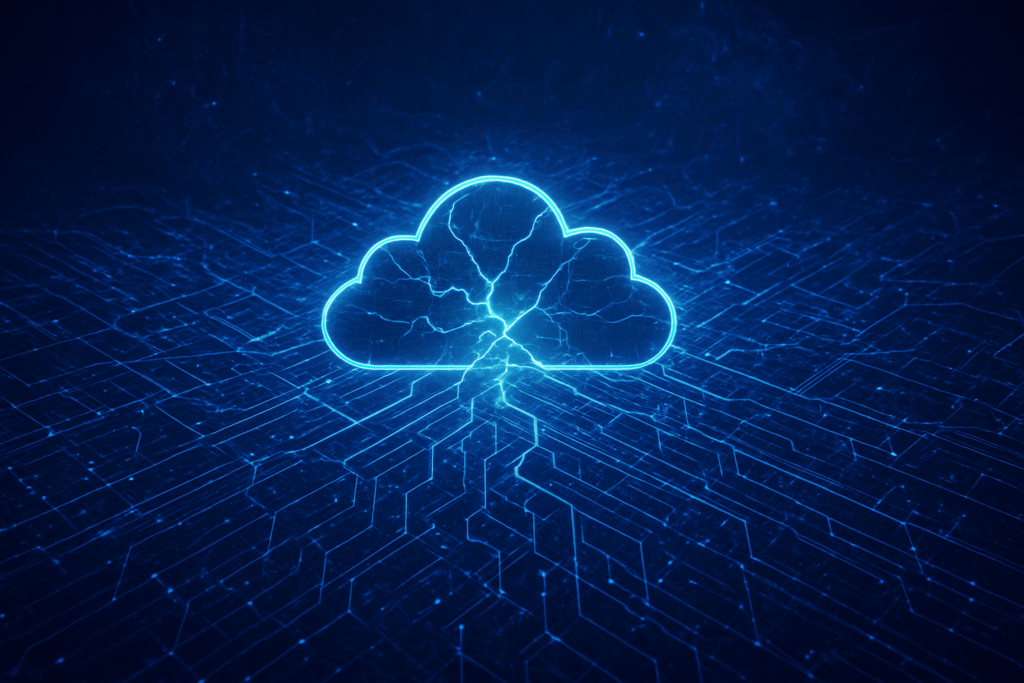
A significant Amazon Web Services (AWS) outage on October 20, 2025, plunged a vast swathe of the internet into disarray, underscoring the profound and increasingly precarious global reliance on a handful of Big Tech cloud providers. The incident, primarily affecting AWS's crucial US-EAST-1 region in Northern Virginia, crippled thousands of applications and websites, from social media giants to financial platforms and Amazon's (NASDAQ: AMZN) own services, for up to 15 hours. This latest disruption serves as a stark reminder of the cascading vulnerabilities inherent in a centralized cloud ecosystem and reignites critical discussions about internet resilience and corporate infrastructure strategies.
The immediate fallout was immense, demonstrating how deeply embedded AWS infrastructure is in the fabric of modern digital life. Users reported widespread difficulties accessing popular platforms, experiencing service interruptions that ranged from minor annoyances to complete operational shutdowns for businesses. The event highlighted not just the technical fragility of complex cloud systems, but also the systemic risk posed by the internet's ever-growing dependence on a few dominant players in the cloud computing arena.
Unpacking the Technical Breakdown: A DNS Domino Effect
The October 20, 2025 AWS outage was officially attributed to a critical Domain Name System (DNS) resolution issue impacting DynamoDB, a cornerstone database service within AWS. According to preliminary reports, the problem originated from a routine technical update to the DynamoDB API. This update inadvertently triggered a "faulty automation" that disrupted the internal "address book" systems vital for services within the US-EAST-1 region to locate necessary servers. Further analysis suggested that the update might have also unearthed a "latent race condition"—a dormant bug—within the system, exacerbating the problem.
In essence, the DNS resolution failure meant that applications could not find the correct IP addresses for DynamoDB's API, leading to a debilitating chain reaction across dependent AWS services. Modern cloud architectures, while designed for resilience through redundancy and distributed systems, are incredibly complex. A fundamental service like DNS, which translates human-readable domain names into machine-readable IP addresses, acts as the internet's directory. When this directory fails, even in a seemingly isolated update, the ripple effects can be catastrophic for interconnected services. This differs from previous outages that might have been caused by hardware failures or network congestion, pointing instead to a software-defined vulnerability within a critical internal process.
Initial reactions from the AI research community and industry experts have focused on the inherent challenges of managing such vast, interconnected systems. Many highlighted that even with sophisticated monitoring and fail-safes, the sheer scale and interdependence of cloud services make them susceptible to single points of failure, especially at foundational layers like DNS or core database APIs. The incident serves as a powerful case study in the delicate balance between rapid innovation, system complexity, and the imperative for absolute reliability in global infrastructure.
Corporate Tremors: Impact on Tech Giants and Startups
The AWS outage sent tremors across the tech industry, affecting a diverse range of companies from burgeoning startups to established tech giants. Among the most prominent casualties were social media and communication platforms like Snapchat, Reddit, WhatsApp (NASDAQ: META), Signal, Zoom (NASDAQ: ZM), and Slack (NYSE: CRM). Gaming services such as Fortnite, Roblox (NYSE: RBLX), Xbox (NASDAQ: MSFT), PlayStation Network (NYSE: SONY), and Pokémon Go also experienced significant downtime, frustrating millions of users globally. Financial services were not immune, with Venmo (NASDAQ: PYPL), Coinbase (NASDAQ: COIN), Robinhood (NASDAQ: HOOD), and several major banks including Lloyds Bank, Halifax, and Bank of Scotland reporting disruptions. Even Amazon's (NASDAQ: AMZN) own ecosystem suffered, with Amazon.com, Alexa assistant, Ring doorbells, Apple TV (NASDAQ: AAPL), and Kindles experiencing issues.
This widespread disruption has significant competitive implications. For cloud providers like AWS, Google Cloud (NASDAQ: GOOGL), and Microsoft Azure (NASDAQ: MSFT), such outages can erode customer trust and potentially drive enterprises to re-evaluate their single-cloud strategies. While AWS remains the market leader, repeated high-profile outages could bolster the case for multi-cloud or hybrid-cloud approaches, benefiting competitors. For companies reliant on AWS, the outage highlighted the critical need for robust disaster recovery plans and potentially diversifying their cloud infrastructure. Startups, often built entirely on a single cloud provider for cost and simplicity, faced existential threats during the downtime, losing revenue and user engagement.
The incident also underscores a potential disruption to existing products and services. Companies that had not adequately prepared for such an event found their market positioning vulnerable, potentially ceding ground to more resilient competitors. This outage serves as a strategic advantage for firms that have invested in multi-region deployments or diversified cloud strategies, proving the value of redundancy in an increasingly interconnected and cloud-dependent world.
The Broader Landscape: A Fragile Digital Ecosystem
The October 20, 2025 AWS outage is more than just a technical glitch; it's a profound commentary on the broader AI landscape and the global internet ecosystem's increasing dependence on a few Big Tech cloud providers. As AI models grow in complexity and data demands, their reliance on hyperscale cloud infrastructure becomes even more pronounced. The outage revealed that even the most advanced AI applications and services, from conversational agents to predictive analytics platforms, are only as resilient as their underlying cloud foundation.
This incident fits into a worrying trend of centralization within the internet's critical infrastructure. While cloud computing offers unparalleled scalability, cost efficiency, and access to advanced AI tools, it also consolidates immense power and risk into a few hands. Impacts include not only direct service outages but also a potential chilling effect on innovation if startups fear that their entire operational existence can be jeopardized by a single provider's technical hiccup. The primary concern is the creation of single points of failure at a global scale. When US-EAST-1, a region used by a vast percentage of internet services, goes down, the ripple effect is felt worldwide, impacting everything from e-commerce to emergency services.
Comparisons to previous internet milestones and breakthroughs, such as the initial decentralization of the internet, highlight a paradoxical shift. While the internet was designed to be robust against single points of failure, the economic and technical efficiencies of cloud computing have inadvertently led to a new form of centralization. Past outages, while disruptive, often affected smaller segments of the internet. The sheer scale of the October 2025 AWS incident demonstrates a systemic vulnerability that demands a re-evaluation of how critical services are architected and deployed in the cloud era.
Future Developments: Towards a More Resilient Cloud?
In the wake of the October 20, 2025 AWS outage, significant developments are expected in how cloud providers and their customers approach infrastructure resilience. In the near term, AWS is anticipated to conduct a thorough post-mortem, releasing detailed findings and outlining specific measures to prevent recurrence, particularly concerning DNS resolution and automation within core services like DynamoDB. We can expect enhanced internal protocols, more rigorous testing of updates, and potentially new architectural safeguards to isolate critical components.
Longer-term, the incident will likely accelerate the adoption of multi-cloud and hybrid-cloud strategies among enterprises. Companies that previously relied solely on one provider may now prioritize diversifying their infrastructure across multiple cloud vendors or integrating on-premise solutions for critical workloads. This shift aims to distribute risk and provide greater redundancy, though it introduces its own complexities in terms of management and data synchronization. Potential applications and use cases on the horizon include more sophisticated multi-cloud orchestration tools, AI-powered systems for proactive outage detection and mitigation across disparate cloud environments, and enhanced edge computing solutions to reduce reliance on centralized data centers for certain applications.
Challenges that need to be addressed include the increased operational overhead of managing multiple cloud environments, ensuring data consistency and security across different platforms, and the potential for vendor lock-in even within multi-cloud setups. Experts predict that while single-cloud dominance will persist for many, the trend towards strategic diversification for mission-critical applications will gain significant momentum. The industry will also likely see an increased focus on "cloud-agnostic" application development, where software is designed to run seamlessly across various cloud infrastructures.
A Reckoning for Cloud Dependency
The October 20, 2025 AWS outage stands as a critical inflection point, offering a comprehensive wrap-up of the internet's fragile dependence on Big Tech cloud providers. The key takeaway is clear: while cloud computing delivers unprecedented agility and scale, its inherent centralization introduces systemic risks that can cripple global digital services. The incident's significance in AI history lies in its stark demonstration that even the most advanced AI models and applications are inextricably linked to, and vulnerable through, their foundational cloud infrastructure. It forces a reckoning with the trade-offs between efficiency and resilience in the digital age.
This development underscores the urgent need for robust contingency planning, multi-cloud strategies, and continuous innovation in cloud architecture to prevent such widespread disruptions. The long-term impact will likely be a renewed focus on internet resilience, potentially leading to more distributed and fault-tolerant cloud designs. What to watch for in the coming weeks and months includes AWS's official detailed report on the outage, competitive responses from other cloud providers highlighting their own resilience, and a noticeable uptick in enterprises exploring or implementing multi-cloud strategies. This event will undoubtedly shape infrastructure decisions for years to come, pushing the industry towards a more robust and decentralized future for the internet's core services.
This content is intended for informational purposes only and represents analysis of current AI developments.
TokenRing AI delivers enterprise-grade solutions for multi-agent AI workflow orchestration, AI-powered development tools, and seamless remote collaboration platforms.
For more information, visit https://www.tokenring.ai/.








